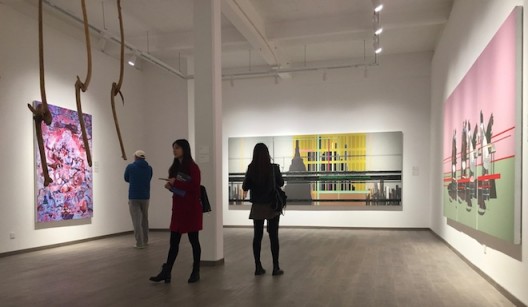For a long time M50 and Moganshan Road was Shanghai’s (very) little 798 District. It was the cynosure of art production, with ShanghART and major artists like Zhang Enli and Xu Zhen long-term residents. But ShanghART has moved to the new West Bund cultural district, as has Aike Dell’arco and MadeIn Gallery. More than once it was whispered that M50 would fade into obscurity. The rumours are premature. M50 has adapted to its new circumstances very quickly. Established galleries like Vanguard and Antenna have only strengthened and they are joined by numerous worthy competitors, such as A+ Contemporary and the new Ying Art Center along Moganshan Road. In addition, Chronus Art Center, Shanghai’s Kunsthalle for multimedia art, and the new Cc Foundation provide vital intellectual ballast for M50′s more commercial vessels. Moganshan is not just alive, it seems to be thriving.
“Datumsoria” with Liu Xiaodong, Carsten Nicolai, Nam June Paik, at Chronus Art Center
Curated by Zhang Ga. zkm Karlsruhe and Nam June Paik Art Center, Chronus Art Center‘s “Datumsoria” is an essay about the past and present of multi-media art, and our imminent future as data processors, and about the processing of data for visual consumption and the robotisation of consumers. Nam Jun Paik’s new Ghenghis Khan greets visitors to planet Chronus. He is made up of an old diving helmet and bits of plastic piping and his horse is a tatty bicycle, but never mind, this Mongol emperor brings tele-vision, vision from a distance, all neon lights and buzzing tubes, as incomprehensible as a message from the stars and the old Hollywood science fiction movies. He greets us from an empire that surrounds us yet we still do not recognise.
Beyond Ghenghis, robots paint Liu Xiaodong’s new cyborg paintings, drawing on data from a live video feed from Shanghai’s Bund, Beijing’s Apple store and Liu’s hometown—landscapes of the future. Liu’s work is famously about place and instantaneity but here it has been outsourced and mechanised. The very human element that was always fundamental to Liu’s practice has been undermined and thrown back at us with rude ‘originality’. Finally, in a darkened room, Carsten Nicolai converts data from old punchcards into pulsating LED graphic messages, hieroglyphs from our immediate past, knowledge ghosts and secret messages, drawing on the punchcards devised by Joseph-Marie Jacquard (1752–1834) to allow mechanical looms to weave complex patterns. And the humanity in this is…where? Visitors cannot help but feel like lab rats blinded by science.”Datumsoria” is full of such knotty questions though, glitches and circular codes, a DNS attack on the brain. Chronus rises.
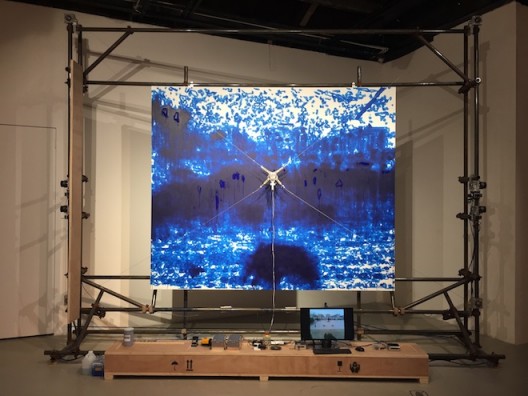


Ying Art Space
Ying Art Center was first established in Beijing as a gallery, collection and publishing company. Their new space at 97 Moganshan Road is capacious, combining a few predecessor gallery spaces, including M97 Gallery (now at 363 Changping Road, Jing’an District). Launched in time for the Shanghai Biennale opening week, Ying Art Center’s first show was curated by Fu Xiaodong, who also runs Beijing’s Space Station. The opening exhibition, “Self-cultivation—The Personal Technology of Living Soma” was aimed squarely at showcasing Ying’s diverse collection and artist roster. Noteworthy are a series of 24 drypoint etchings by Wu Yi and two paintings by Zheng Guogu (who suddenly seems to be in everyone’s collections) but the highlight was Yang Jian‘s video and installation about the weight of a soul, the difference between the weight of a dead body and what is left over when everything corporeal has gone.
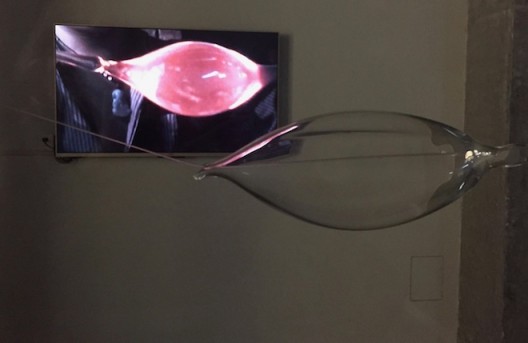

Zhan Rui “7278/12” at Gallery 55
In Zhan Rui’s first solo show in Shanghai, time is represented in blocks of everyday events, such as weather data, stock market movements and attendance numbers. Every aspect of life is covered without any actual life lived, and yet reality ends up being precisely what is represented: we become our categorisation, and worse, maybe only functions thereof. The system folds in on itself, but quite happily. In his new series, “7278/12”, the subject analyzed is the artist’s own monthly income from teaching at the art academy. Zhan Rui’s practice of observation and process could be wry were it not for the relentlessness of the numbers he shows are consuming us. Observe yourself, and take note. Gallery 55
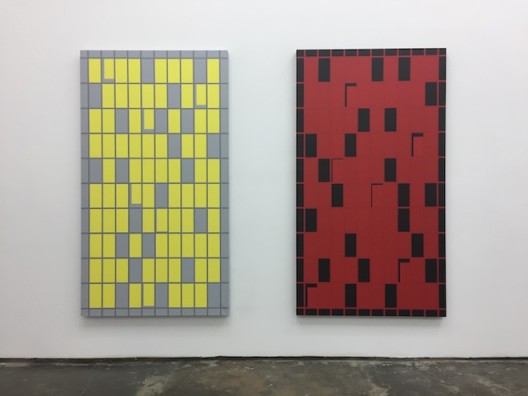

Nadim Abbas “Chimera” at Antenna Space
We have already written about this show but it deserves another mention. Nadim Abbas’s first show at Antenna Space was a mind-delighting game of wordplay and science-fiction jokes. “Chimera” denotes a hybrid monster (part-lion, -goat, -snake) of classical mythology from Asia Minor and also a “3D molecular visualization program developed at the University of California, San Francisco”—and realities collide and one becomes the other. Meanwhile in “Human Rhinovirus 14“ (2016) the “common cold” is represented as balls floating above centrifugal blower fans. Disease is a language and neither is completely under control. The conclusion is “Chamber 667/668″ (2016), a pair of empty laboratories at the wings of the exhibition, with only abandoned toilet paper rolls to indicate humans were there. Forget neo-abstraction, we are in the best Zombie artwork since Cao Fei’s “Haze and Fog” (2013), which incidentally involves a scene with a woman in a bath with blow-up watermelons. Disease can be fun.
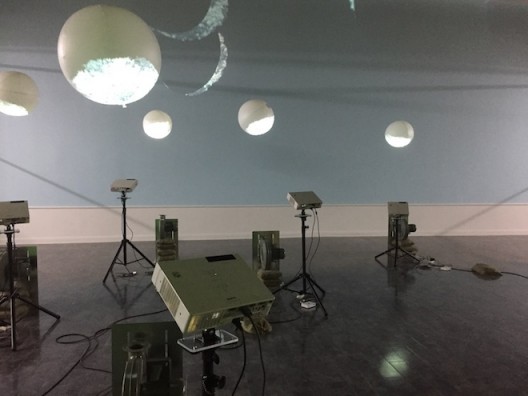

He Yide “Right Misplacement” at A+ Contemporary
A+ Contemporary is related to Taipei’s renowned Asia Art Center, which also has a space in Beijing’s Dashanzi 798 Art District. A+ Contemporary has a reputation for finely curated and presented shows and this was further underscored by He Yide’s solo exhibition “Right Misplacement” (October 29-December 11, 2016). He Yide uses found objects and happenstance to react to spaces with anti-monumental sculptures. Boxes are repurposed as small cabinets, a piece of felt cloth curls up against a wall, and a clay horseshoes hands from an MDF an upended shelf leaning against a well. It is human and lyrical and open to anyone who wants to see it. And if you are not looking, you will trip over it and get a real sculptural feeling.
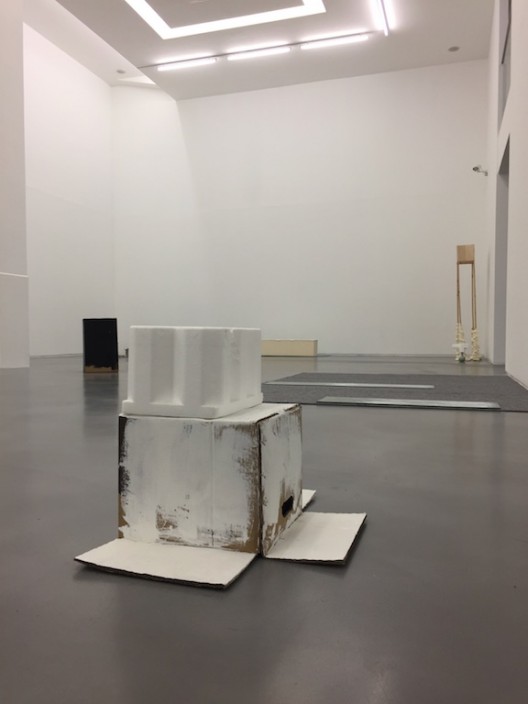
Thomas Zipp “The Threshold Problem and Some Possible Ways to Solve It” at Cc Foundation & Art Center
Shanghai art collector and entrepreneur, David Chau, launched his Cc Foundation in Songjiang, on the outskirts of Shanghai. Songjiang is home to a community of artists supported by affordable (for Shanghai) studio space. Cc Foundation now also has art spaces in Hong Kong and, since November, in M50 too. The latter opened with an exhibition by Austrian artist, Thomas Zipp—his first in China. Visitors could remote-control ungainly robot dummies (it’s about artificial intelligence—geddit?) and also witness a disturbing operation on another. I preferred sending the dummies to run over collectors—I gave myself extra points if the victim fell over (I sort of had to leave after I got to 11 but I am sure I could have done better).
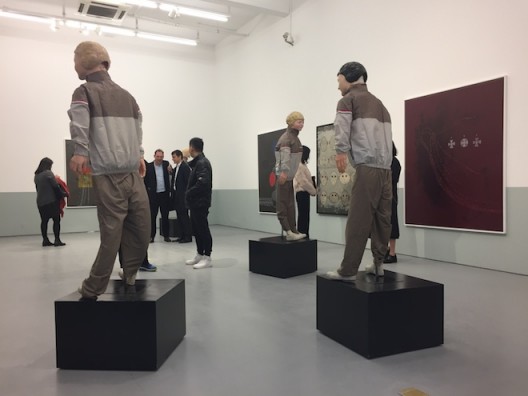
Hsu Che-Yu “No News from Home” at Vanguard Gallery
Lise Li’s Vanguard Gallery, has been one of the stalwarts of the M50 complex. A small, independent gallery with carefully curated shows. As Vanguard has matured, its repertoire has expanded from programmes mainly comprising small-scale painting, photography and video shows, to include immersive installations. During West Bund and ART021, the gallery showed Hsu Che-Yu’s latest hybrid-video, continuing in work begun with “Microphone Test”, exhibited in 2015 at The Taipei Fine Arts Museum. “No News from Home” again mixes autobiographic reality with fiction to examine dissonance between memory (private experience) and official strictures (society)—what is recorded and what is not.
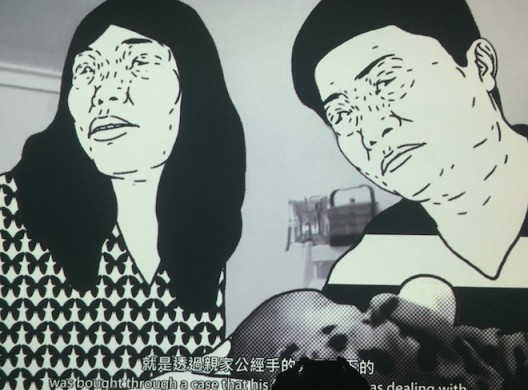
Yun Suk-nam “The Hollow” at Korean’s Hakgojae Gallery
Korean galleries are working intensely to build their China networks. Kukje is a regular presence at Art Basel Hong Kong and ARARIO has long been present in China, first in Beijing and now in Shanghai. During West Bund and ART021 Hakgojae showed Korean artist, Yun Suk-nam (b.1939, Manchuria) in a solo show, “The Hollow”, Yun is a noted member of Korea’s artist-feminist movement, including joining “October Group”, whose members were opposed to depicting Western art removed from everyday Korean lives. Accordingly the major work in the show was “Fish Market II” and installation of hand-painted wooden fish … that also whimsically chastises Korean society. (Also watch out for the Yuz Museum’s “Dansaekhwa” show later this year.)
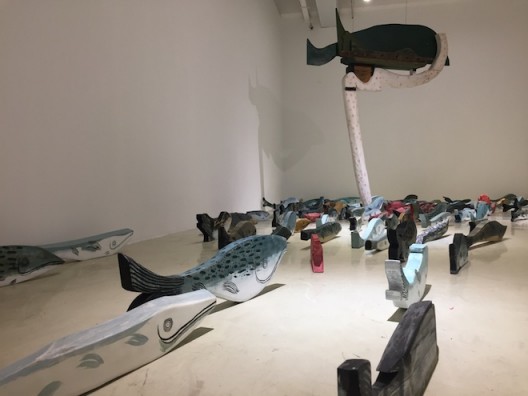
Na Space
Li Huina is a young Shanghai collector. And she has opened an exhibition space for her collection in M50. Like most private collections, it is a bit mixed. On the other hand, one of the great things about collectors in China is that they are so willing to show their collections. It is partly competitiveness and one-upmanship but it is also about ambition and pride. It is in the West too but not so much, although the Selfie generation may be changing that. Anyway, the Liu Wei’s are great.
